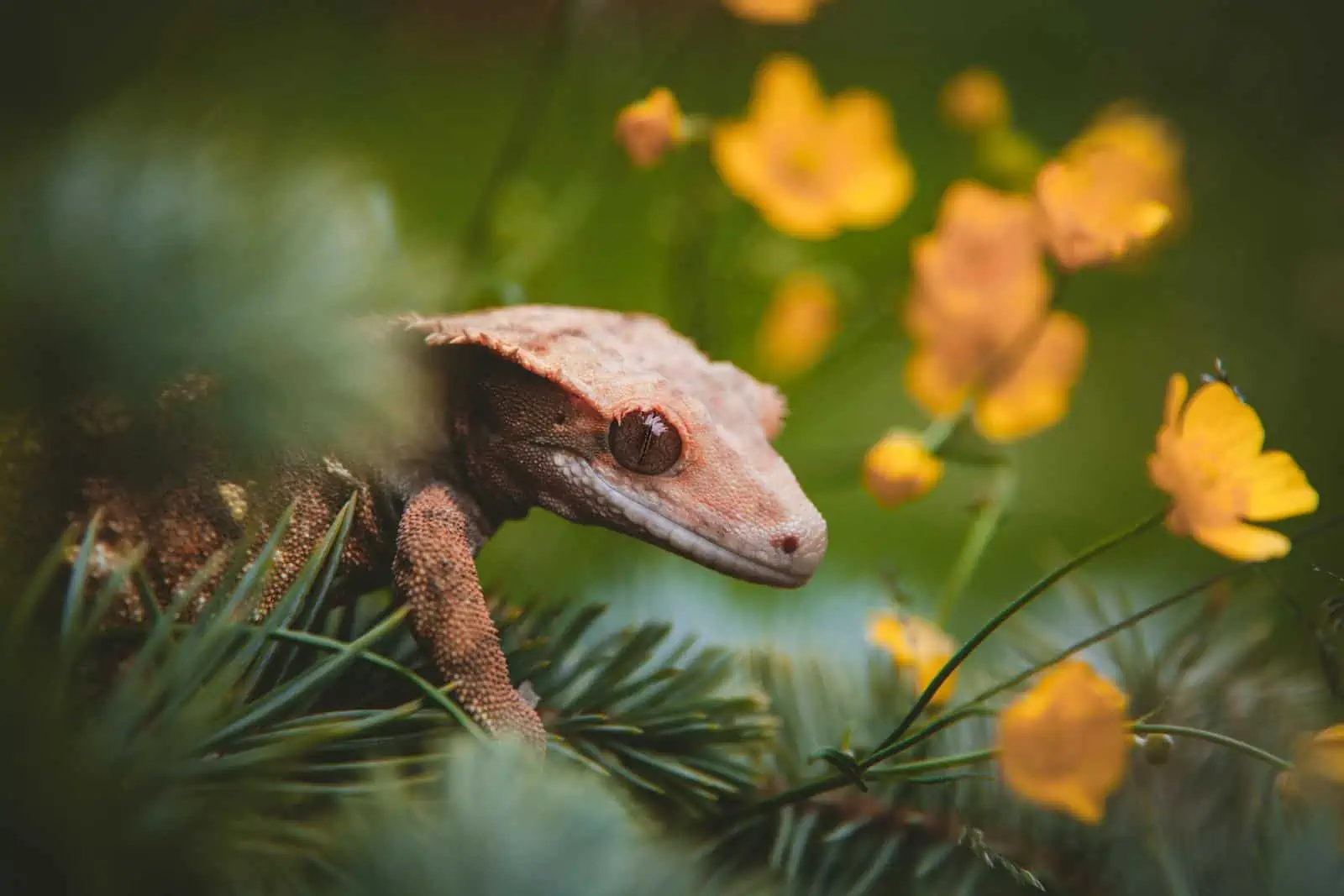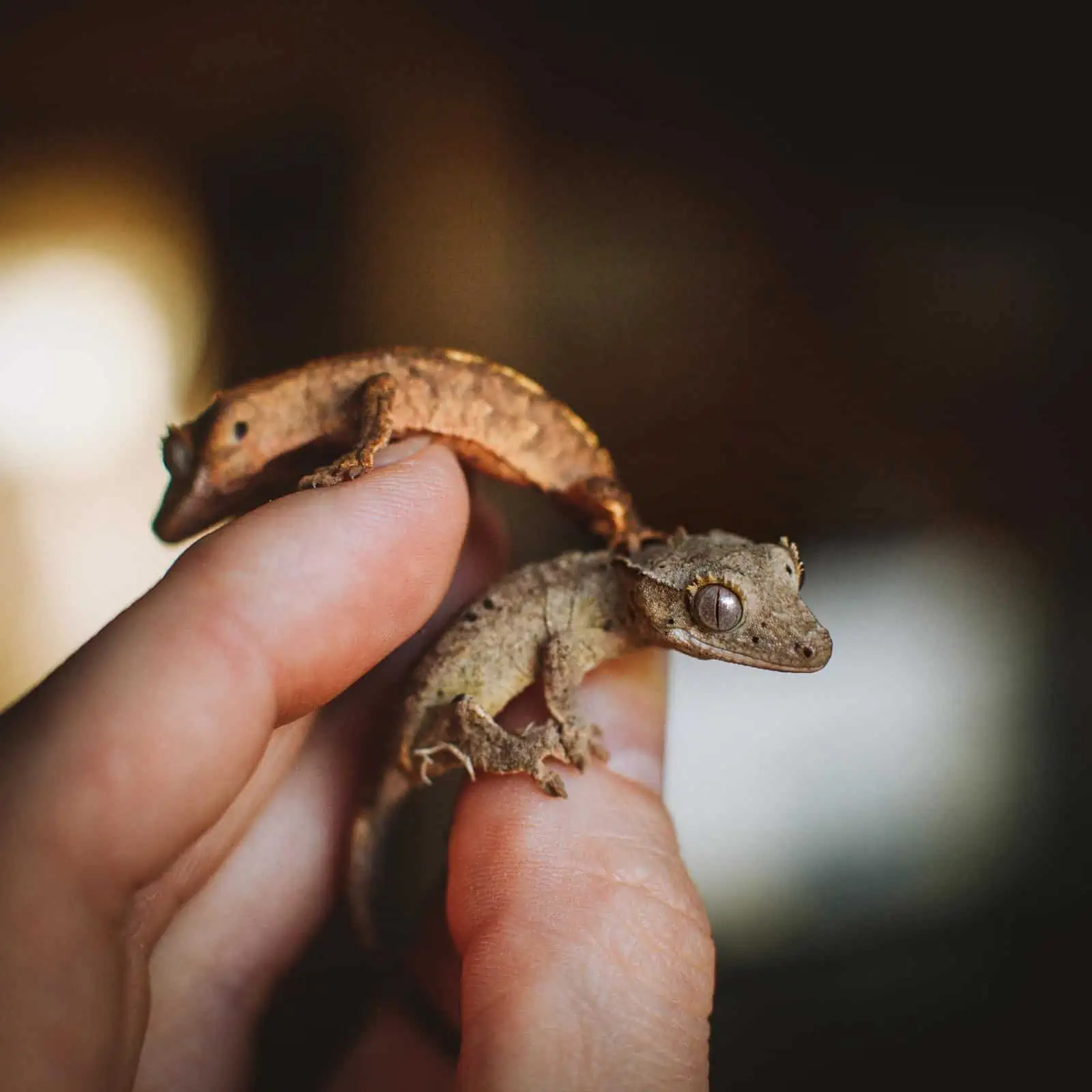New reptile owners often want to determine the gender of their pets. It’s essential for choosing a name & figuring out if they can cohabitate or breed. But examining Crested Geckos’ bodies might be tricky, as they don’t have the obviously visible sex organs other more common house pets have.
That said – once they reach a certain age – there are some key indicators you can look for to identify your gecko’s gender. The most important ones are:
- Pre-anal pores
- Hemipenal bulge
There are also other methods – but mostly these are not accurate to sex your crestie – these include:
- Size of the body & head
- Cloacal spur size
- Sexual behavior
- Size of calcium sacs
In this blog – we’ll discuss how to successfully determine the sex of your Crested Gecko. Let’s get started!
Why Is It Important To Know the Sex of Your Crested Gecko?
It is important to determine whether your gecko is male or female – despite it appearing insignificant at first. Below I’ve mentioned important reasons why you should do so early on.
Co-Habitation
If you own a crested gecko and are thinking about letting them cohabitate – it’s important to know their sex.
You can’t house two males together – as they’ll likely be aggressive during mating season or territorial with one another & can end up harming each other.
On the other hand – if you’re housing a male & female together – you’ll need to keep an eye on them. Make sure the male isn’t bullying or becoming physically aggressive with the female.
However – it’s fine to house multiple females in the same enclosure that has all the facilities & is big enough for each of them to have their own spot.
Breeding
If you’re interested in breeding your crested geckos – there’s one essential step: Sexing them. You’ll need one female & one male – so if you don’t know the gender of yours, it’ll be a bit trickier to get hatchlings.
Diet Planning
Knowing the sex of your crested gecko is essential for providing them with an optimal diet: your female lil reptile will need more nutrients – particularly calcium – since they lay eggs with or without mating.
This takes a toll on their calcium reserves & can lead to metabolic bone disorder if the gecko isn’t provided with a balanced diet.
So – you need to be aware of your gecko’s needs in order to give them the best-care.
Naming
Lastly – knowing the sex of your reptile buddy can be helpful when it comes to picking a name. If you know whether your gecko is male or female – you can pick out a name that suits them best.
At What Age Can a Crested Gecko Be Sexed?
To determine the gender of your crested gecko – you need to wait until they exhibit specific attributes & it may take some time. Generally – they reach their sexual maturity at around 9-10 months. However – you can most likely identify if it’s a male or female once your cute lizard is 4-6 months old & weighs 8-16 grams.
Unfortunately – younger geckos cannot be precisely sexed – so make sure to have an idea of how old your little one is first.
When your reptile reaches 4 months – you can quickly tell its gender through the slight sexual dimorphism displayed in them. This distinction becomes more visible as they get older.
Pet stores may not know the exact date of birth – but they should have a record of when they received it – and that can help you figure out its approximate age.
When combined with their size and weight – you can get close to knowing your reptile’s exact age.
What Methods Can You Use to Sex Your Crested Gecko?
Sexing a Crested Gecko can be tricky & requires careful observation. Fortunately – there are a number of methods that you can use to help determine the sex of your lil monster. By learning & following these techniques – you can ensure that you get an accurate reading of the gender of your reptile pal.
Look for the Pre-Anal Pores
It can be hard to see – but preanal pores on your Crested Gecko can help you figure out whether it’s a boy or girl before it reaches sexual maturity.
Male cresties have a faint, horizontal line of pores just above their vent (in the girdle area), which look like tiny tan or brown dots – one ‘dot’ per scale. You can often identify these pores by looking for areas where the scales are shinier than others. However – it’s important to note that this is not always the case. The gecko secretes a waxy pheromone-filled substance from these pores to attract potential mates – in the wild and captivity!
Your little pal’s preanal pores will typically start showing up when it’s around four months old. At this point – experienced Crested Gecko keepers can usually figure out the sex of the gecko with some certainty. But – the pores may not be as clear until they’re about 9 to 10 months old.
Do Pre-Anal Pores Exist in Females?
Yes – females might have something like pores sometimes, too – but they’re not real. They’re called pseudo-pores – and they’re much tinier than the ones males have.
Usually – they’re scattered sporadically around rather than in a clear pattern – so if you spot just one, that doesn’t necessarily mean it belongs to a male. Meanwhile – the males’ pores are usually arranged in neat lines & they may even have some smelly liquid secretions that the females’ pores don’t.
This is thanks to those pheromones we talked about above.
Look for the Hemipenal Bulge
To determine the sex of your reptile – you can typically identify males by searching for a bulge called the hemipenal bulge located at the base of their tail.
This bulge is quite obvious on adult crested geckos, making it easy for you to recognize. However – on juvenile geckos, the bulge can be more subtle.
So why the bulge? 🧐
It’s actually where the pair of hemipenes – which are organs used for sperm transfer during reproduction, are stored. Despite its nickname of “gecko-balls,” it’s not actually composed of testes like in humans. Hemipenes look more like a lumpy mass than an elongated penis.
If you want to be sure of the sex of your gecko – wait till they’re around six months old. That’s when you should start to see the bulge develop & become more prominent as they age up to a year old. The bulges are visible from various angles, including the side, below, and sometimes even above.
Do Female Crested Geckos Develop Hemipenal Bulges?
You won’t find any hemipenal bulges on female crestie – they don’t have ’em! That said – some females may have fat deposits in the area where males typically display theirs. This is often the case if your lizard friend is a bit chubby.
Anyway – the size of this area tends to stay the same as the female reaches maturity. So even if your girl is a bit on the hefty side her ‘bulges’ will remain relatively small.
Other Indicators To Determine Your Crested Gecko’s Sex
In addition to pre-anal pores & hemipenal bulges – other physical features can help you identify the sex of your crested gecko.
Body and Head Size
You can also tell your crested gecko’s gender by looking at their overall body & head shape: males typically appear larger & stockier with a broader head – while females are slimmer & smaller.
To use this method – you need to have other reptiles whose gender you already know for comparison. However – don’t be fooled: this isn’t always the case!
Every gecko is unique – so it’s important to consider different factors before drawing conclusions.
For instance – if your gecko lives with others & struggles to grab its fair share of food it may be smaller than average despite being a male.
Bottom Line: In short – checking your gecko’s size can help confirm its gender only if you’ve used the two initial methods & have some clarity about your crested gecko’s gender, then the overall body & head shape can serve as a confirmatory process.
Cloacal Spur Size
No matter if your Crested Gecko is a boy or a girl – you’ll spot two pointy white horns poking out from the side of its base – that’s the cloacal spur.
It’s in the same spot that you’ll find the hemipenal bulge.
Usually – males have bigger ones than females – but the size isn’t everything because female geckos can have larger spurs too.
So if you’re trying to figure out your pet’s gender – don’t rely on spurs alone. Take this into account & assess the size of the spurs, too – only while you are using other methods – but remember, it’s not a definite sign either way!
Sexual Behavior
When your Crested Geckos begin mating – you can determine their gender by observing their position. The male gecko will be on top – while the female gecko will be underneath. Therefore by observing their position – you can identify their gender.
However – it is important to note that one instance of seeing a gecko on top of the other is not enough to determine their gender. But – if you consistently observe them in the same position, you should be able to determine their respective genders.
Size of Calcium Sacs
Crested geckos have small calcium sacs inside their mouths – specifically on the roof. These sacs store extra calcium & female geckos have larger sacs than males. This is because females require more calcium to ensure their eggs are healthy & robust. However – if your gecko is too young or isn’t getting enough calcium – it may have smaller sacs or none at all.
If you need more confirmation of your reptilian pal’s sex – you can use these indicators. However – make sure to use the first two methods I mentioned earlier – as they are more accurate, especially if your gecko is less than a year old.
How To Handle Your Crested Gecko To Confirm Its Gender
Handling your Crested Gecko requires you to be gentle & patient at all times.
- When approaching the enclosure – make sure your buddy can see you. Then – take your time to smoothly stroke the gecko before carefully lifting it with your fingers.
- Remember – a Crested Gecko cannot regrow its tail once it’s dropped – so be sure to only hold the gecko by its body.
- Hold onto them with a firm yet gentle grasp.
- To sex your pet gecko – it’s smart to get a friend to help you out. One of you should hold the gecko up or in a slightly vertical position while the other checks its belly with a flashlight or takes close-up pics.
- To get a closer look at the small pre-anal pores or what’s happening between their legs – you can also use a loupe magnifier or a jewelry loupe. These tools can zoom in up to 60X.😉
You can easily check out your lizard pet’s belly without removing it from its enclosure: just take some photos through the vivarium glass when the gecko is up against it. Or – you can place the gecko in a clear-bottomed bowl or container & peek underneath.
What Are the Additional Distinctions That Separate Male and Female Crested Geckos?
In addition to their physical differences, male & female crested geckos also exhibit several distinct health problems that can help you identify the gender of your pet.
Health Problems
Crested geckos come with their own set of health issues. Male crested geckos can experience health problems associated with hemipenes-prolapse. This occurs when the hemipenis is unable to retract inside the body & remains outside. Initially – providing light pressure can help in pushing it back in. However – leaving the hemipenes outside for too long can cause them to dry out and become infected.
Female Crested Geckos are at risk of health issues related to their ability to lay eggs even without a male present. A condition called egg-binding can occur when the eggs get stuck inside the female’s body. Treating egg binding may require surgery – which can be expensive & traumatic for the female. To prevent this condition – you must be aware of the female’s egg laying cycle and provide enough calcium in her diet.
Life Span
The average lifespan of a Crested Gecko is ~15-20 years – but they could even reach the ripe old age of 30! Males usually live longer than females, but this isn’t always a sure thing.
Is It Possible for a Crested Gecko To Change Its Gender?
No – a crested gecko cannot change its gender: what you buy is what you get!
Gender is determined at birth & stays the same for its entire life. Now – don’t be fooled by sellers or breeders who claim they can tell male from the female when the gecko is still a baby – this isn’t possible.
You can only be sure of the gender after it reaches 4 months old. So – if you thought you bought a female gecko, but it turns out to be male – don’t worry; your pet hasn’t changed genders; it was just misidentified.
Does the Gender of the Crested Gecko Depend on Temperature?
Certain types of geckos do not possess sex chromosomes that determine the gender of their offspring. Instead – they have temperature dependent sex determination (TSD) – meaning the gender of their babies is determined by the temperature at which their eggs are incubated.
On the other hand – crested geckos have a ZZ/ZX system of sex chromosomes similar to humans’ XX/XY system. So – there’s nothing you can do to increase the probability of getting either a male or female crested gecko hatchling – they come in a 1:1 ratio. In simpler terms – if you have a bunch of eggs, there’s a good chance half of them will be male & the other half female.
To Sum It Up
In conclusion – sexing a crested gecko is not always an exact science – but with careful observation & practice, you can learn to identify whether your gecko is male or female. Be sure to pay attention to the hemipenal-bulge & pre-anal pores of the gecko since these are key indicators in determining gender.
You should also look for other physical characteristics that may help you identify the sex of your gecko.
Have you ever sexed a crested gecko? How did it go? Let us know in the comments!




